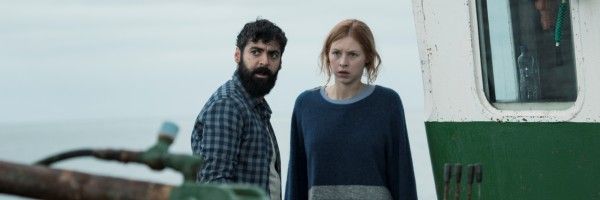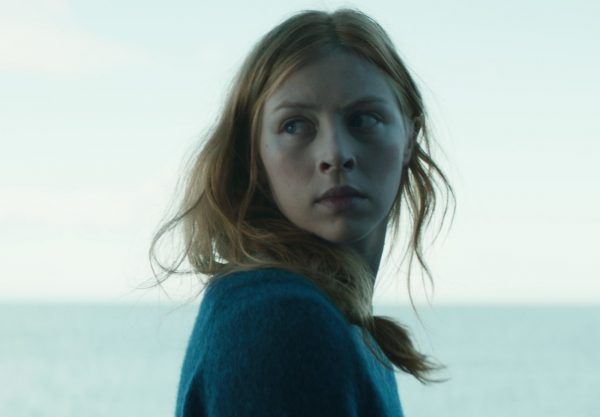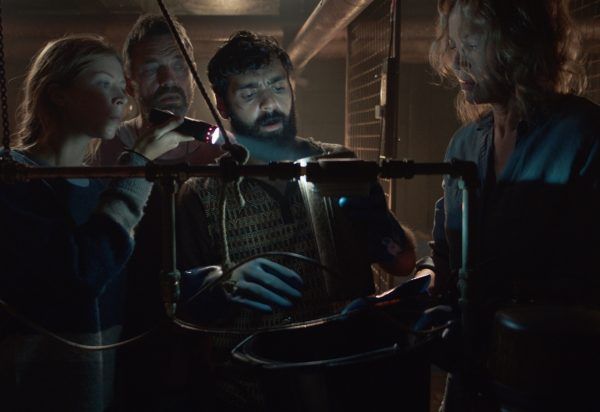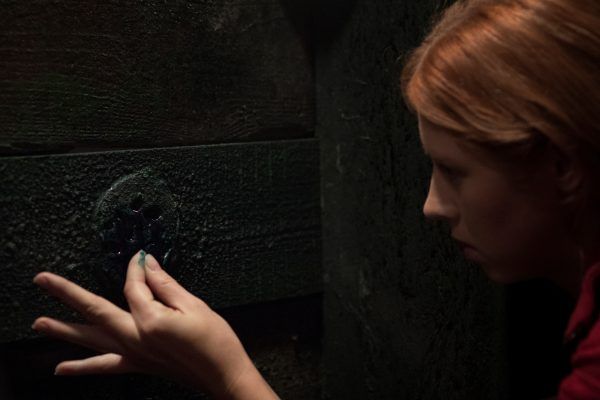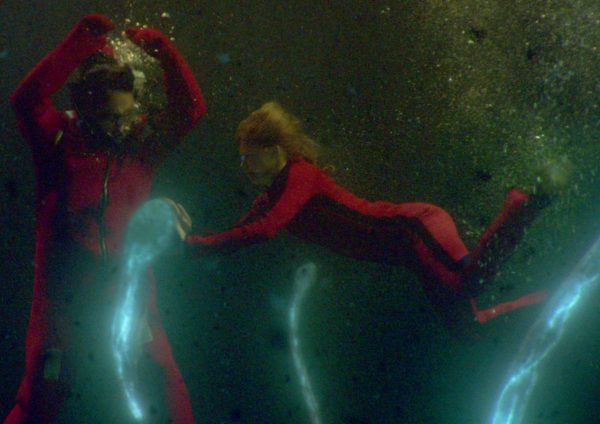From writer/director Neasa Hardiman, the indie horror film Sea Fever shows what can happen when a mysterious lifeform ensnares a fishing trawler out in the deep Atlantic with its crew on board. When marine biology student Siobhán (Hermione Corfield) has to endure a week on a boat whose close-knit crew starts to succumb to a strange infection that is taking them out, one by one, she attempts to understand its source and how to stop it.
During this 1-on-1 phone interview with Collider, British actress Hermione Corfield talked about the new relevance of this story, what attracted her to this character, the changes to the film’s opening scene, and the experience of shooting this film on a boat and on set. She also talked about how being a part of blockbuster productions compares to smaller films, memorable moments on Mission: Impossible - Rogue Nation and Star Wars: The Last Jedi, and making the action film The Misfits with Renny Harlin and Pierce Brosnan.
Collider: This movie seems very relevant to what we’re all currently experiencing. When this project came your way, did you get to read a full script, right away, or did they just give you some scenes?
HERMIONE CORFIELD: I got to read the whole script. I read it, and then I had a Skype with (writer/director) Neasa [Hardiman] to talk about it. Then, I went to meet her in Dublin. So, I knew the whole story. It went through a few changes before we shot it, but the shape of it is pretty much the same, so I was aware of what of what it was. Obviously, now, it’s even more relevant and eerie.
When you did that first read of the script, what were the things that most stood out for you and struck you about this story?
CORFIELD: What I felt, from the beginning, was that I really liked how Siobhán was the scientist at the center of the story, but she was a complicated person. She approached things with the scientific method and struggled to see the nuances between people, but she so wanted to do the right thing and to connect with people. And I liked that she’s not your archetypal hero. She’s someone that does have flaws and is vulnerable. She’s not the big hero that comes and saves the day, in one sweep, and everyone loves her and thinks she’s great. She is quite disliked, at the beginning, and that’s real. Most of the time, people that are whistleblowers and who speak the loudest aren’t necessarily the most liked. I really liked that about it.
So much of the success of a film like this comes from the mood and the atmosphere and the tension that it creates. Were you able to get that from reading it, or did that come out of conversations with the director?
CORFIELD: That definitely came in conversations. I remember being given a slideshow with images of the kind of visuals that they were going for. I had an idea of the blues and the rust, but until I actually saw the interior of the ship, it was then that I was like, “Oh, wow, okay.” It was so beautifully done and so thought through. The colors were amazing and it just looked fantastic. It’s interesting, the U.S. poster looks very similar to one of the first images that I saw. I quite enjoyed that.
You talked about there being a bit of an evolution with the script. What kind of changes happened? Were there any major changes, or were they just small evolutions?
CORFIELD: Maybe just small evolutions. Initially, she dives in the first opening scene. She and Jack [Hickey]’s character were out in a boat, diving. You were immediately introduced to her in the setting of joining this boat and the crew. But then, it changed to getting to see here in a lab, in this ultra clean environment, so that when you do see her on the boat, you get more of a contrast between where she feels safe and where she feels pushed out of her comfort zone.
Did you want to play this character because she was someone that you could understand and identify with, or did you want to play her because she’s so different from who you are?
CORFIELD: It was a mixture of both. She is incredibly different to myself, and I found it a challenge. One of the best things about acting is being receptive to other people and picking up on other people’s emotions and nuances, and how that then creates a dynamic between the characters. With this, because she struggles so much to communicate, I had to learn to not be so receptive to other people and not pick up so much on other people. That was very different to myself ‘cause I think I’m quite good at reading people and understanding how people are feeling. That was hard to switch off, when playing her. But there were parts that I do understand. I do understand what it is to not be listened to. I do understand what it is to want to communicate something so bad, and not being able to do that. There were elements of her that really rang true to me, and there were elements of communication that I struggled with because it’s so different from myself.
With everything going on in our world now, it’s easy to see that there are very current themes in this film, with a parasite infecting and killing human beings. Do you look at this film differently now, especially with everything going on? Does it feel even scarier and more real?
CORFIELD: Now, with everything that’s happening, it feels a lot more real. It was always a poignant message, but for me, the poignancy came from the idea of preserving the world and not messing with mother nature. That was the original message that I took from that. There’s this creature that’s just trying to survive, itself, and it’s a rare species, and they’re so quick to want to kill it to protect themselves. And Siobhán’s message is, “This isn’t about you. This is about the world. This is about everyone else.” Originally, when I really took from it was the environmental message about the responsibility to not destroy the fishing industry, to not over fish, but to not destroy mother nature and this thing that keeps the whole world turning. But now, with everything that’s going on, the other message that’s also ringing as loud is about human responsibility, not just for the world and the environment, but also human responsibility for everyone else. It’s about not just looking out for the individual, but for everyone else. You might not necessarily know you have it, but you could be carrying it. And now, in this climate, it rings incredibly poignant and very eerie. It makes you wish that we’d listened. That’s what everyone should walk away thinking.
How was the experience of actually shooting this film? What was it like being on a boat versus being on a set?
CORFIELD: We did external shots, up on the decking of an actual boat. For the interiors, they built an exact replica of internal layout of a boat, so it was claustrophobic and tight. You could go from the kitchen down to the bedroom and to the shower. It was all connected, or at least most of it, which was amazing. We went to the same set, every day, and it was a small set. We were all there together, and it was very tight and created a family dynamic.
What have you learned from the experience of being on some of the big sets that you’ve been on, whether it was Star Wars: The Last Jedi, King Arthur: Legend of the Sword, Mission: Impossible - Rogue Nation, or XXX: Return of Xander Cage? How different of an experience is it to be a part of something like that compared to smaller or more independent movies?
CORFIELD: It’s just a scale thing, to start with. They’re so vast and huge, but with directors like Chris [McQuarrie] and Rian [Johnson], it’s doesn’t feel intimidating. It’s exciting. They make it feel intimate because they’re so brilliant and welcoming. It’s mainly a scale thing, I would say, and a food truck thing, as well.
Are there any particularly memorable moments, from any of those films, that will always stand out for you?
CORFIELD: Yeah, the whole experience for Mission: Impossible, just because it was one of my first jobs. It was exciting and surreal to be doing that. And then, with Star Wars, I was filming something, at the same time, so I was going back and forth. It was huge excitement. I was going from this period drama that was shooting on one side of London, to Star Wars on the other side of London. It was a crazy time. It was surreal to even be on a Star Wars set, but it was also so different from the other project I was doing, at the same time, and that made it even more surreal.
You’ve also shot The Misfits with Renny Harlin. What was it like to work on an action film with him, and alongside Pierce Brosnan?
CORFIELD: It was a really fun experience. I met Renny ages ago on Skype, when I was 19, for another film that he was doing, and I ended up being too young for it. So, I knew him from that, but we didn’t really make the connection until I’d flown out there and seen him again. We were in Abu Dhabi, in a completely different place, and it was really fun because we also got to experience the culture together. We went out to the desert, and that was very extreme conditions. We had a few sandstorms and we rode camels. It was quite a crazy time, but it was so much fun.
What kind of character do you play in that?
CORFIELD: I play Pierce Brosnan’s daughter, who is one of the people that orchestrates the heist. I work in refugee camps, which is her drive for being there, in the first place. She’s trying to get this money to use it for aid.
Sea Fever is available On Demand and on Digital on April 10, 2020.

